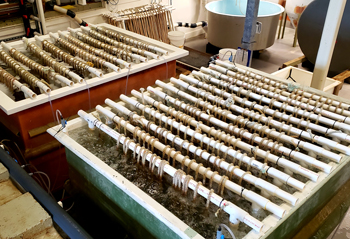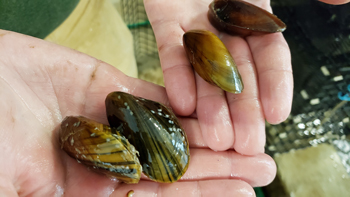DEI’s ‘Gold’ Mussel Could Open Markets to Maine Aquaculture
by Sarah Craighead Dedmon

DEI’s selective breeding of eastern mussels has produced gold mussels like these, which have an overall blonde tone, and sometimes feature black and gold vertical stripes. “They’re stunning,” said Pepperman. Photo courtesy DEI.
You walk into an upscale Boston eatery and order mussels dressed in garlic almond butter. A bowl of steamy shellfish come to your table, but first they could have come from anywhere in the world: Spain, New Zealand, Chile or, most likely, eastern Canada.
“The United States imports $50 million annually from Prince Edward Island alone,” said Kyle Pepperman, aquaculture production and research assistant at Beals’ Downeast Institute (DEI). “New Zealand just invested $20 million in a quasi-public hatchery. You look around the world, people are doing this.”
Most domestic mussels come from the west coast. The Downeast Institute would like to help Maine mussel farmers change that, by providing reliable seed source, plus something that could set their product apart on the table.
“Eastern blue mussels are usually blue, sometimes they look black, but there’s a really rare occurence of them being gold and striped, they’re really pretty,” said DEI Executive Director Diane Tilton. “We were able to selectively breed them, and we’ve had a lot of success with it.”
Last month, Pepperman celebrated a record ‘gold’ mussel spawn that produced more than 30 million larvae. “At this time last year I was thinking 10 million per spawn was pretty good. When we’re working out the economics, most of the cost is during the larval period, so when you can get three times the product for the same effort, that’s great.”

DEI utilizes old lobster rope as a substrate for their mussel seed, a step which keeps costs low, and prevents the rope from heading to a landfill. Photo by Sarah Craighead Dedmon.
Those economics are central to DEI’s strategy, because they’re working to create an affordable business model that could draw more Mainers into aquaculture, and also earn more money for existing mussel farmers like Evan Young. At Blue Hill Bay Mussels, Young has been raising trials of DEI’s gold mussels, grown in a salt pond on submerged ropes. His first commercial harvest will be ready in 2021.
“We’re calling them ‘Blue Hill Blondes,’” said Young. “Every year that we harvest, we select the broodstock. I think we’re on the third or fourth generations of the blondes now.”
Young is excited about the Blondes’ market potential, which could fetch an extra $.50 or a $1 above typical $2-per-pound wholesale prices. But Young is even more enthusiastic about DEI’s creation of a sustainable mussel seed source, no matter the color. Without commercial mussel seed, Young can’t buffer his business against seasonal ups and downs.

Evan Young of Blue Hill Bay Mussels has been raising test generations of ‘gold’ eastern mussels, and hopes to harvest the first commercial crop in 2021. He plans to market them as “Blue Hill Blondes.” Photo courtesy Evan Young.
“Right now in the wild we only get a seed-set once a year and that hasn’t been a consistent thing. For two out of the last three years, we’ve gotten very little seed collection,” said Young. “In order to be sustainable in the market year around, we started five or six years ago working with [DEI] about coming up with ways that we could do this.”
In the DEI hatchery, Pepperman manages tanks hung with lobster rope slung over PVC pipe. The rope was headed for a landfill, but at DEI gets a second life as a substrate for larval mussels. Once the larvae reach a certain size, the ropes can be delivered to a mussel farm. Farmers could then use the seed ropes to supplement the natural settlement that takes place in July and August.
“It’s an 18-month cycle, so they could put these in April, and harvest in January,” said Pepperman. “If you’re adding some of these into your business model, you could offset when you’re going to have animals going to market.”

DEI’s Kyle Pepperman hoists a crate of ‘gold’ mussel broodstock from a tank at the institute’s Beals Island hatchery. Photo by Sarah Craighead Dedmon.
There are currently no shellfish aquaculture sites in Washington County, where DEI is based. This year Pepperman is overseeing several mussel test sites there, to compare how fast the blue and gold mussels grow in its colder waters. If the results are positive, DEI is planning to partner with the Sunrise County Economic Council and Downeast Fisheries Partnership to offer some business strategies and expertise to would-be Washington County mussel farmers.
“We’re doing that test this summer, and if we do find that’s the case, then the SCEC and DFP will help with money and lease applications. Things like, how do they get the gear, what kind of gear do they use, etcetera,” said Tilton. “It’s not like you can just walk into the aquaculture business, so we’re getting those ducks in a row.”
If all goes well, demand could outstrip DEI’s hatchery capacity, but Pepperman said that wouldn’t be a bad thing. “If this really takes off, and we do have this huge outpouring of interest, we’d probably encourage a for-profit business to take it and run with it,” said Pepperman.
For Tilton, transferring that technology into the private sector would be an ideal end game.
“We’re a nonprofit, and all of our research is all about economic development, all the time. It’s why we were organized, it’s a part of our mission,” said Tilton. “Usually the goal of research is to wind up in commercialization at some point. That is always our goal.”

